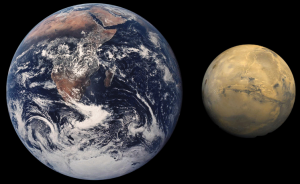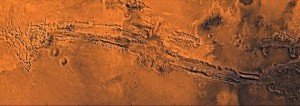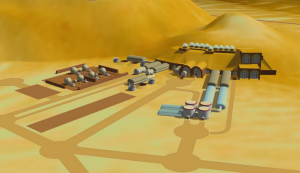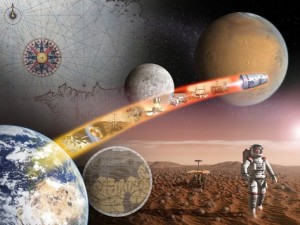by: Nicole Willett
The Mars Society is dedicated to the human exploration and settlement of the planet Mars. As such the Education Task Force is charged with educating the public with everything about Mars. A general overview is the best way to introduce the Red Planet. That leaves a sense of curiosity and room for further inquiry into the subject.
The following is a brief overview of the planet Mars.
General Information:
- The planet Mars was named after the God of War from Greek/Roman mythology.
- It is the 4th planet from the Sun, also known as the Red Planet.
- Mars has what is known as a superior orbit – meaning it orbits the Sun outside of the orbit of Earth.
- Orbit Order: Sun—Mercury—Venus—Earth—Mars—Jupiter— Saturn— Uranus—Neptune
- Mars orbits the Sun at an average distance of 1.5 Astronomical Units (1 AU is the distance from the Sun to the Earth).
- Mars is regarded as the 2nd most hospitable planet for the appearance of life, after Earth.
- Mars is about half the size of Earth.
- A year on Mars is 687 Earth days.
- A day on Mars is 24 hours and 37 minutes.
- The axial tilt on Mars is 24o, which gives Mars seasons similar to those on Earth.
- Mars’ surface gravity is 1/3 of Earths.
- The temperatures on the Martian surface range from -87oC to 20oC.
Mars has 2 satellites (moons) named Phobos and Deimos:
- The moons are oddly shaped and look like potatoes!
- They are much smaller than Earth’s moon.
- Phobos and Deimos orbit Mars very quickly and are much closer to Mars than the Moon is to the Earth.
- The satellites are visible through some larger telescopes on Earth.
Some major geographical features on Mars:
- Valles Marineris – A 3,000 mile long “Grand Canyon” that looks like a giant crack on the surface of Mars.
- Olympus Mons – The largest volcano on Mars and in the solar system, it is 3 times as high as Mt. Everest and the size of Texas!
- Mars has thousands of craters covering its surface, and they range in age from billions of years old to others that are much more recent.
Water and weather on Mars:
- Telescopic observations from Earth have seen what appear to be channels on Mars for many years.
- Many orbiting spacecraft have taken images of dry river channels on the Martian surface.
- The landers and rovers on Mars have taken measurements, soil samples and images that have led to an overwhelming amount of data that suggests water existed on the surface of Mars, is there now in frozen form and occasionally briefly runs across the surface when the conditions are just right.
 Mars has a North and South Pole that are covered in ice caps. The ice caps grow and recede through the seasons and are made of H2O and CO2.
Mars has a North and South Pole that are covered in ice caps. The ice caps grow and recede through the seasons and are made of H2O and CO2.
Mars has Earth-like weather systems, including clouds, wind, dust storms and it even snows on Mars!
Major U.S. spacecraft to have visited Mars:
- Mariner 4 – 1964 launch, flyby mission, July 1965, took the very first close-up images of Mars
- Viking 1 Lander – reached the surface July 20, 1976
- Viking 2 Lander – reached the surface Sept 3, 1976
- Mars Pathfinder and Sojourner Rover (2-part spacecraft) – reached the surface July 4, 1997, first rover deployed on another planet
- Spirit Rover – reached the surface Jan 4, 2004
- Opportunity Rover – reached the surface Jan 25, 2004-Still operating on the surface of Mars
- Phoenix Lander - reached the surface May 25, 2008
- Curiosity Rover - reached the surface Aug 5/6, 2012-Still operating on the surface of Mars
The spacecraft listed above have carried many scientific instruments including spectrometers, rock abrasion tools, many types of cameras, chemistry labs, a drill and even a laser. The discoveries they have made are varied, such as the discovery of the first meteorite on another planet, that water existed on the surface of Mars and in the soil, the inside of the rocks on Mars are grey (not red!), and that there are simple organic molecules inside the rocks on Mars. These are just a tiny sample of what has been discovered on the Red Planet in recent years.
 The Mars Society is dedicated to the human exploration and settlement of Mars. Part of this goal includes promoting educational outreach with STEM subjects. Many scientists believe that the Red Planet can be terraformed (made Earth-like) over the next few centuries, providing humanity with a second home. In order for the human race to accomplish these goals, we must educate ourselves and each other. Please join us in helping to reach our objective.
The Mars Society is dedicated to the human exploration and settlement of Mars. Part of this goal includes promoting educational outreach with STEM subjects. Many scientists believe that the Red Planet can be terraformed (made Earth-like) over the next few centuries, providing humanity with a second home. In order for the human race to accomplish these goals, we must educate ourselves and each other. Please join us in helping to reach our objective.~On To Mars
Contact for inquiries or volunteer information: nicolew@marssociety.org
Also please visit our Main website: http://www.marssociety.org
[Images: The Mars Society, NASA, JPL, Exploremars.org]

















